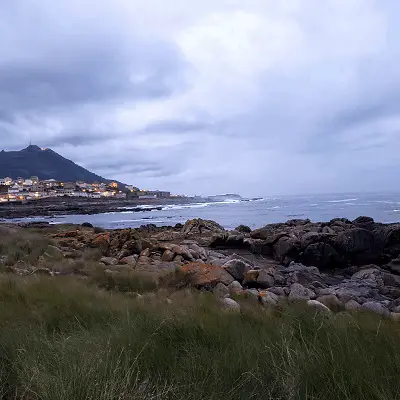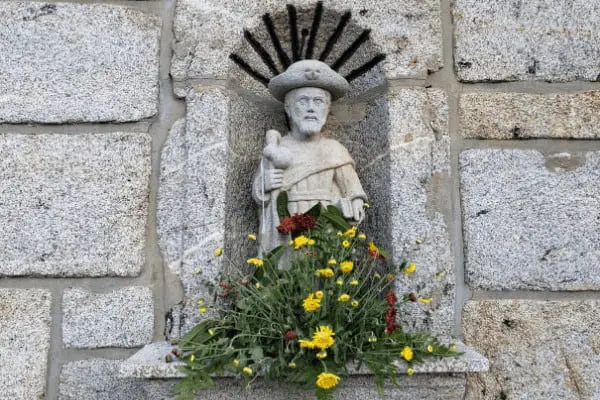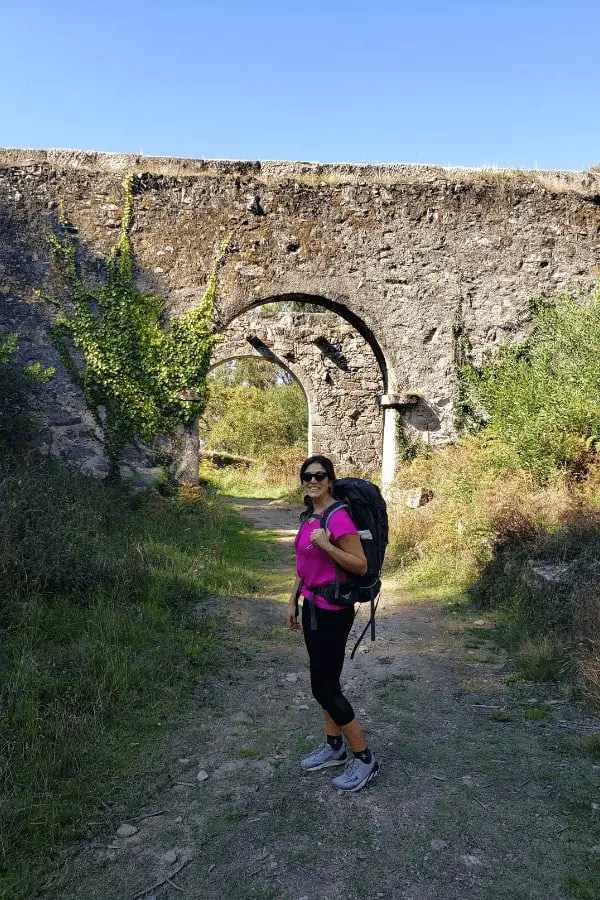
The Portuguese Camino route is RAPIDLY growing in popularity. While the French Way is still the most walked route, pilgrims looking for an off the beaten path experience (not to mention stunning coastal views) should consider the Portuguese Camino route.

To help you decide if the Portuguese Camino is right for you, keep reading for answers to the most frequently asked questions about the Camino Portugués. In this post, you’ll find out what it’s really like to walk from Porto to Santiago de Compostela with a special emphasis on the Portuguese Camino Coastal route.
Get answers to questions like:
- Where does the Portuguese Camino start?
- How long does it take to walk the Portuguese Camino?
- How far is the Portuguese Camino?
- Is it safe to walk the Portuguese Camino alone?
- Do you need a guide to walk the Portuguese Camino?
- Should you take rest days on the Portuguese Way of St. James?
Plus helpful information and tips about:
- Choosing between the Camino Portuguese Coastal or Central routes
- Best walking months for the Portuguese Camino
- Accommodation on the Portuguese Camino
- The Cost of the Portuguese Camino
- What to pack for the Portuguese Camino
Alright, let’s get to the good stuff! Read on to find out what it’s REALLY like to walk the Portuguese Camino route.
When you’re finished, check out this post with 25 eye-opening things you need to know BEFORE walking the Camino.
Walk Porto to Santiago de Compostela on the Portuguese Camino

In October 2019, I arrived in Porto, Portugal, with my Osprey Kyte 36 on my back and a brand new pair of Altra running shoes on my feet. Six hours earlier, as I boarded the overnight bus from Madrid, I realized I was really doing it. I was going to way the Portuguese Way of the Camino de Santiago.
Related Reading:
- Portuguese Camino Coastal Route Stages {2020 13-Day Guide}
- How to Prepare for the Camino de Santiago in 3 Easy Steps
Like many pilgrims, the Portuguese Way was not my first Camino. In 2016, I walked the last 100 km of the French Way and hated just about every minute of it.
Even though I didn’t enjoy my first Camino, I thought about it almost daily over the next three years. When the opportunity presented itself, I knew I had to walk again. The Camino was calling.
My experience walking the Portuguese Camino could not have been more different from my first. It was everything I thought my first Camino would be — and more.
Whether you’re a first-timer or seasoned pilgrim, I highly recommend the Portuguese Camino. After my experience, I fully understand why it is the second most popular Camino route. This guide will help you understand what it’s really like to walk from Porto to Santiago de Compostela and if the Portuguese Way is right for you.
Where does the Camino start in Porto?
The Camino starts in Porto at the Sé Cathedral. It’s a major landmark in the city center and easy to find.
If you don’t already have your pilgrim credentials, you can purchase it there. Sé Cathedral is open from 9 a.m. to 5:30 p.m. every day.
Portuguese Camino Coastal Route

The Portuguese Camino has two routes that the majority of pilgrims walk: the coastal route and the central route. In October 2019, I elected to walk the Portuguese Camino Coastal route.
There is also a third route called the Senda Litoral (Literal Way). The best way to leave Porto for the Portuguese Camino is following the Senda Litoral along the Rio Douro. So, if you can’t make up your mind between the coastal route and the central route, you have some time to decide since the first day of walking is the same for both.
What’s the Portuguese Camino Coastal route like?
As you might have guessed, the Portuguese Camino Coastal route follows the coast. While there are plenty of stunning sea views, this route doesn’t keep you pegged to the coastline. In addition to the coast, the Portuguese Camino Coastal route takes you through dunes, towns and forests.
As I said, I walked the Portuguese Camino Coastal route in 2019. Here are the reasons I chose it over the Portuguese Camino Central route:
- Fewer people walk the Coastal route compared to the Central route.
- I wanted more of an off the beaten path experience.
- There is less walking along busy roads compared to the Central route.
- I found this to be true, but it’s important to be mindful of traffic even in small towns.
- There is less up and downhill walking compared to the Central route.
- I did NOT find this to be true. While you’re not climbing any mountains, there is still significant up and downhill walking. I had the shin splint from HELL to prove it!
What’s the Portuguese Camino Central route like?
While I haven’t personally walked the Portuguese Camino Central route, I talked to many pilgrims who chose this particular way. The two routes converge at various points, so many people end up walking a combination of the two.
Here are a few things to know about the Portuguese Camino Central route:
- It’s the busier of the two routes with approximately 70% of pilgrims walking the Portuguese Camino Central route.
- Because it’s more popular, there is more catering to pilgrims. Think restaurants, accommodation, backpack shuttle services and English-speaking staff.
How far is the Portuguese Camino route?

From Porto to Santiago de Compostela, the Portuguese Camino Coastal route is 280 km (174 miles).
The Portuguese Camino Central route is 260 km (162 miles) from Porto to Santiago de Compostela.
There is also the option to start the Portuguese Camino in Lisbon. From there, it’s 620 km (385 miles) to Santiago. Only a small percentage of pilgrims walk the Portuguese Camino from Lisbon. Infrastructure for pilgrims between Lisbon and Porto is still in development.
How long does it take to walk the Portuguese Camino?
For pilgrims in good physical shape, it takes approximately two weeks to walk the Portuguese Coastal Camino route.
I walked the Portuguese Camino in 12 days. That was 11 days of walking and one day of rest. I left Porto on Monday, Oct. 7 and arrived in Santiago de Compostela on Saturday, Oct. 19.
Excluding the rest day, I averaged just under 16 miles per day.
For reference, I was 27 years old when I walked the Portuguese Camino. I exercise regularly including running and strength training.
The time it takes to walk the Portuguese Camino will depend on your individual physical fitness. But remember, it’s not a race. If you’re unsure of your ability to walk the Camino, I recommend talking with your doctor.
Is it safe to walk the Portuguese Camino alone?

Yes, it is safe to walk the Portuguese Camino alone! I walked the Portuguese Camino as a solo female pilgrim and never felt scared or uncomfortable.
That being said, it’s always important to be aware of your surroundings. To minimize your vulnerability, I advise you against walking with headphones in if you’re walking solo in the pre-dawn hours. No pump-up playlist is worth putting yourself at risk.
If you’re nervous about setting out on the Camino alone, don’t be. The Portuguese Camino is the second most popular route, and you may actually need to make an effort to walk alone. To say the Camino is social would be an understatement.
I met my walking buddy, Vanessa, on the way out of Porto. We got to chatting, decided to stay in the same place that night and the rest is history. Vanessa and I walked the entire Portuguese Camino together and, four months later, still talk almost daily.
You may start off walking alone, but it won’t take long to find your Camino family.
Do you need a guide to walk the Portuguese Camino?

No, you don’t need a guide to walk the Portuguese Camino. I know there are tours available, but it’s more than possible to walk on your own.
The way is well-marked. Just follow the yellow arrows!
I do recommend having data on your phone so you can access Google Maps. It’s helpful for any time you might need to leave the trail such as finding albergues, restaurants and supermarkets. If you don’t speak Spanish or Portuguese, don’t count on finding English-speaking locals to point you in the right direction.
Should you take rest days on the Portuguese Way of St. James?

If you take anything away from this post, let it be that your Camino is your own. You need to do what you need to do to 1) finish and 2) enjoy it. In some cases, adhering to #2 might mean not doing #1.
What I’m getting at here is, if you need to (or just want to!) take a rest day on the Portuguese Camino, DO IT.
I hadn’t planned on taking a rest day, but the shin splint from HELL forced me to take one in Nigran, Spain. If you’d like to plan your rest day in advance, these are the best cities and towns for rest days on the Portuguese Camino.
Best Places to Take Rest Days on the Portuguese Camino
- Caminha, Portugal
- Oia, Spain
- Baiona, Spain
- Pontevedra, Spain
Best walking months for the Portuguese Camino
I walked the Portuguese Camino in October. While I enjoyed spectacular weather the first week, the second was almost a continuous downpour.
If I had to do it over, I would walk the Portuguese Camino in September. I think the weather would be better, but it’s still shoulder season meaning fewer people on the trail.
If you’re doing the Camino to meet people and want the full pilgrim experience, the best walking months for the Portuguese Camino are June, July and August.
Accommodation on the Portuguese Camino

On the Portuguese Camino, albergues are accommodation specifically for pilgrims. Albergues along the Camino can vary greatly in price, amenities and comfort.
The cheapest option for accommodation on the Portuguese Camino is municipal albergues. The local government runs the municipal albergues. For $5-$8 USD, you get a bed in a shared dormitory.
Often, you’re sharing it with quite a lot of pilgrims. In Pontevedra, I stayed in a room with nearly 40 other people!
In addition to municipal albergues, there are private albergues along the Portuguese Camino. These often cost a little more, but you can get a lot with those extra euros.
On the Portuguese Camino, I also stayed in budget hotels on several occasions. I split the price of a room with another pilgrim, making it an affordable option.
I recommend staying in a mix of municipal albergues, private albergues and budget hotels. You’ll be able to experience the spirit of the Camino, get a few decent nights of rest and still stay on budget.
How much does it cost to walk the Camino de Santiago?
Because I understand how important budgeting is when planning a trip, I wrote an entire post detailing how much it costs to walk the Camino de Santiago.
Overall, I found the Portuguese Camino to be cheaper than walking the last 100 km of the French Way. Prices along the portion of the route in Portugal were cheaper than those in Spain.
What to Pack for the Portuguese Camino
Following my experience on the Portuguese Camino Coastal route, I wrote the packing list I WISH I would have had. From the best women’s backpack for the Camino to my essential nonessentials, check out this post:
Is the Portuguese Camino route the best Camino for you?
If you’re looking for an off the beaten path adventure, consider the Portuguese Camino route. Walking the Portuguese Camino Coastal route was one of the best experiences of my life, and I really can’t recommend it enough.
Of course, the best Camino is one that excites you. If the storied French Way draws you in, go for it. If you want to do something different, check out the Portuguese Camino.
Still not sure which Camino route is right for you? Check out this post with an overview of all the Camino de Santiago routes:
Got questions about the Portuguese Camino route? Comment below!
Psst…Don’t forget to pin this post for later! Follow my Camino de Santiago board on Pinterest for tips, training plans and more fantastic resources!



I was seeking inspiration for setting off from Porto. This was it! Thank you for all of the good tips and information.
Hello,
I plan on going next April or May. I’ll be 63 at that time. Do I book in advance a hostel or hotel? What if I don’t want to walk that distance on a certain day? Also, will I be using US dollars? Is April or May a good month to go? Thank you for your input. It’s greatly appreciated!
I am thinking of doing this between March 10 and March 24. Is this a bad idea for any reason(s)?
Do you have any idea re Covid restrictions in September, how can I find out if the hostels on route will be open? Thank you
This article does not represent The French Way at all. You can’t say you’ve done the Camino by walking the last 100k. So bogus!!!
This post is not about the French Way, Sherry. As the title states, it’s about the Portuguese Way (Camino Portugues).